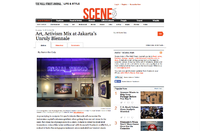Art, Activism Mix at Jakarta’s Unruly Biennale
Sebuah artikel mengenai aktivitas dalam Jakarta Biennale 2013 yang ditulis oleh Samantha Culp di situs online Wall Street Journal. Artikel ini disadur oleh Andreas Siagian pada tanggal 24 Januari 2014. Artikel versi online dapat dilihat di link ini. Berikut salinan dari artikel tersebut:
Anyone trying to navigate this year’s Jakarta Biennale will encounter the Indonesian capital’s infamous gridlock when getting from one art venue to the next. But when the cityscape slows to a crawl, it starts to reveal its street-level innovations: take a bike jacket emblazoned with its owner’s Facebook profile link, or a sheaf of Indo Pos newspapers fashioned into a makeshift car window-shade.
These urban “hacks” may be the perfect introduction to this year’s biennale theme: the Indonesian concept of “Siasat.”
Derived from Arabic, the word is often defined as “tactics,” but has broader implications of strategy, improvisation and creative problem-solving, especially with limited resources. The idea overlaps with jugaad in India, shanzhai in China and “maker” culture world-wide, but with a distinctive Javanese flavor.
Samantha Culp ‘Trash Squad’ by Woto Wibowo (aka Wok the Rock) is a ‘punk cleaning troop’ that does unsanctioned clean-ups of urban litter. More In Art
The spirit of siasat infuses every aspect of the biennale, from the 52 participating artists and groups from 18 countries, to the geographic sprawl of more than 15 locations that span old-town colonial Kota Tua to the suburbs of South Jakarta. At the opening night on Saturday, visitors and artists alike were gleaming with sweat while exploring the main venue, an underground parking garage beneath Taman Ismail Marzuki, the art-and-cultural center where the first Jakarta Biennale took place in 1968.
The unventilated subterranean space, which smelled faintly of diesel and clove cigarettes, proved an ideal backdrop for many of the works, especially those that called into question the boundaries of art itself. While the Indonesian art boom has put high-priced painters in the spotlight, there is a strong social-activist tradition in the local art scene, according to Ade Darmawan, this year’s Biennale director and founding member of leading Jakarta artists’ collective Ruangrupa.
“We know there’s a phenomenon of artists’ collectives working with communities,” Mr. Darmawan said. “There are also communities using an artistic approach to their activism.”
Sanggar Anak Akar, a Jakarta-based NGO, had built a faux-classroom where marginalized youth did an elaborate drumming performance on school desks. Abdulrahman Saleh, aka Maman, had meanwhile worked with local scrap collectors to decorate their carts for an installation that bore slogans such as “Your Trash is My Blessing.”
Though community-based projects have recently become fashionable in the international art world, Moelyono, a veteran activist from East Java, has been teaching art workshops to villagers, children and workers across the archipelago since the early 1980s. Documentation of these workshops, mounted on several walls and tables, offer a deliberately incomplete archive of these activities.
A younger group of artists, designers and eco-activists from Yogyakarta teamed up for “Dining Space Project,” coordinated by a collective called Lifepatch. The piece showcases alternative modes of gardening, glass recycling, utensil-making and even alcohol-distilling within a wooden frame, which holds large glass jugs that transmit the sound of fermentation through mini-speakers. At the opening, samples of its home-brewed tamarind wine quickly ran out.
When asked if the group’s ethos was “D.I.Y.”, a barefoot Krisna Waworuntu, who organizes “Permablitz” edible-gardening events in Yogyakarta, said with a laugh, “We prefer ‘D.W.O.’ – do it with others.”
Samantha Culp ‘Yang Tertinggal (The Ones Left Behind)’ by Mella Jaarsma & Nindityo Adipurnomo. Other artists took a more mischievous approach to the concept of activism. Woto Wibowo, who goes by the name Wok the Rock, is behind the Trash Squad, a 10-person “punk cleaning troop” who do unofficial clean-ups of trash left by the Jakarta bourgeoisie outside its many 7-Eleven stores (they even have a theme-song and punk-inspired uniform logos). “I call it invisible theater, not performance,” he said from his impromptu “office” in the corner of the car park, which served as a temporary Trash Squad home base. “I don’t want to do social activism.”
Many of the projects reference motorbikes and street culture, such as the tongue-in-cheek “Helm Ajaiyp,” by artist Napati Awangga, known as Oomleo. The series modifies motorcycle helmets with whimsical extras, including video screens to be enjoyed by the rider behind you, and an opening through which a girl could thread her ponytail.
There is also plenty of street art: Indonesia has a vibrant street art community, and many established artists got their start in the form, such as Eko Nugroho who represented Indonesia in this year’s Venice Biennale.
For the Jakarta Biennale, Mr. Nugroho splashed his distinctive hand-drawn characters on a toll road tunnel, while artist Guntur Wibowo captured the complex history of crime-ridden neighborhood Kampung Ambon in a wall-length timeline.
Murals painted by seven artists in five locations around the city will remain up after the event ends at the end of the month, adding to Jakarta’s renowned street-art landscape – returning some of “Siasat” to its natural habitat.
The 15th Jakarta Biennale runs from Nov. 9 to 30. Take a virtual tour of the seven urban mural sites.
Correction: The main venue of the biennale is the parking garage beneath arts center Taman Ismail Marzuki. A previous version of this article gave an incorrect spelling of the center’s name.
